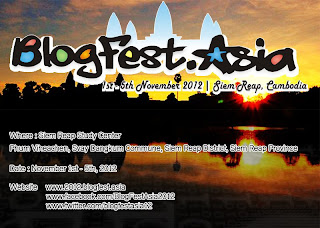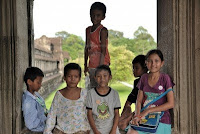 | ||||
| Blogfest Asia 2012 - Blog Competition About Siem Reap Angkor |
 Siem
Reap, being well-known for its richness in cultural, historical and
natural tourism resources, has attracted millions of tourists each year,
thus contributing largely to the Cambodian economy. In 2010, just Siem
Reap alone accounted for 52% (1,305,256)
share of the total number of tourist arrivals in Cambodia. This high
number of tourist arrival has created economic opportunities for many
people, but not limit to children living in the town. The
tourism-related jobs in Siem Reap range from the very small scale ones
such as individual sale of souvenir, which is usually seen among
community people and small children, to the very big ones such as hotel
and/or restaurant, which is usually held by rich Cambodian businessmen
or foreign investors. If we pause here for a while and look at this
situation, we could see that tourism indeed is a good source of income,
especially for the local community people since they can earn a living
to support their daily livelihood. However, let me draw your attention
to something on the dark side of tourism and what harm it may bring to
the people, especially children. The following paragraphs describe
further on my point of view over my one-or-two-day observation during my
time travelling around Siem Reap town and the main discussion is
centered on the concept: “While providing opportunities, tourism also puts children at vulnerabilities.”
Siem
Reap, being well-known for its richness in cultural, historical and
natural tourism resources, has attracted millions of tourists each year,
thus contributing largely to the Cambodian economy. In 2010, just Siem
Reap alone accounted for 52% (1,305,256)
share of the total number of tourist arrivals in Cambodia. This high
number of tourist arrival has created economic opportunities for many
people, but not limit to children living in the town. The
tourism-related jobs in Siem Reap range from the very small scale ones
such as individual sale of souvenir, which is usually seen among
community people and small children, to the very big ones such as hotel
and/or restaurant, which is usually held by rich Cambodian businessmen
or foreign investors. If we pause here for a while and look at this
situation, we could see that tourism indeed is a good source of income,
especially for the local community people since they can earn a living
to support their daily livelihood. However, let me draw your attention
to something on the dark side of tourism and what harm it may bring to
the people, especially children. The following paragraphs describe
further on my point of view over my one-or-two-day observation during my
time travelling around Siem Reap town and the main discussion is
centered on the concept: “While providing opportunities, tourism also puts children at vulnerabilities.”
Looking
on the bright side, tourism provides very good chances for children in
the town, especially those whose houses are situated around the main
attraction sites, in terms of cash income, linguistic development, and
pleasure from communication with various types and nationalities of
tourists. From my short conversations with some children from different
famous tourism spots in Siem Reap, they could earn approximately between
10,000 and 20,000 Riel daily at an average from selling souvenir,
postcards, t-shirts, and books to tourists. With this money, they could
use some of it to buy their own materials, toys, or sweets while they
give the rest to their parents or caregivers. Coming to the language
these children know, it gave me a little bit of surprise at the
beginning that they could speak at least 4 or 5 foreign languages while
English is the main one followed by Korean, French, Japanese, Chinese,
etc. These children’s ability to learn foreign languages are driven by
the nationality of tourists visiting a site. “I need to sell something
to them, and if I can speak their language, they might choose to buy
from me,” said a souvenir seller child in Banteay Kdei temple compound.
These children could use the languages they learn quite efficiently but
the idea governs around the linguistic terms of very basic conversation
and getting a product sold. They will not understand if you go farther
around some other technical terms. However, at least children learn
extra knowledge and they are able to convey what they intent to speak.
If you ask these children if they are happy to be out in the field on
these types of work, they would of course response with a smiley face
saying they are very happy. “I like selling books to tourists, and I am
very happy when they buy one from me,” said a small girl in Angkor Wat
temple area. These children enjoy communicating with tourists, and they
are also very happy playing with their friends.
Despite
these good things tourism do to children, there are chances that
children suffer from tourism as well. There have been report cases
already in Siem Reap that children have their rights violated owing to
this tourism sector in the forms of child labor abuse, education, child
trafficking and sexual abuse, and neglect. Child labor in tourism and
education are closely related and contributing to one another. At this
age, children should be in schools. Instead they are out in the field
chasing after tourists for the income. Even though there are a small
amount of children who go to school in the morning and come to sell the
products in the afternoon or vice versa, most of them drop out of school
at grade 3, or at worst case never attend school at all. These children
could not rely on selling products forever. What they need more at this
time is schooling and education, but tourism has twisted this around
and put children at risks. Another important issue is the child
trafficking and sexual abuse. From a research
by Thomas in 2006, the perpetrator and the buyer of child sex in
tourism sector are mostly those foreign tourists who come to visit a
particular place, and child sex tourism can be found in almost every
popular tourism sites in Cambodia: Phnom Penh, Sihanouk province, and of
course Siem Reap. The victims tend to be poor children with low or
without education and those without appropriate care living on the
street, (Corridors of Children, 2010).
Last but not least, the vulnerability that tourism brought to children
is that fact that children are ignored and not being paid attention to
by both the tourist and parents/caregivers. This issue might not be seen
as a high risk to children but it is absolutely a form of abuse to
children. When chasing tourist in order to promote their products, most
of the time these children are ignored. Imagine you are talking to
someone and they pretend not to hear or do not want to talk back to you,
how would you feel and how this affects you as an adult? To children,
it potentially affects their mental healthiness and their behavior. More
than this, the parents or caregivers are not aware of and regard this
as a problem since their children could earn some income for the family.
This is ignorance over the neglect which is a double danger on
children, and this is solely of tourism, not to mention the other
sectors.
To sum it up, I would say tourism indeed is a very strong sector in Siem Reap, contributing to the local economic sector, and it makes changes in lives of community people and children in town. However, along with these positive impacts, we all should be aware that some Cambodian children in Siem Reap are also at risks due to this tourism. I, therefore, would like to call for a more responsible tourism in Siem Reap and in Cambodia as a whole where best interests of children are placed up front so that people and tourists are aware of and willing to protect children.
Nice article and reflection brother! I totally agree with you and I really hope people are paying more attention on the children.
ReplyDeleteGood job my friend!
ReplyDeleteHaha.. I am back!
Delete